IHRM4032: HRM Strategies & Practices, Oxfam Case Study Analysis
VerifiedAdded on 2023/06/10
|14
|3372
|140
Report
AI Summary
This report provides an analysis of human resource management (HRM) within the context of a case involving Oxfam. It covers key HR functions, including workforce planning, employee relations, and performance management. The report addresses people management issues, such as handling sexual harassment claims and the importance of aligning HR strategies with business objectives. It also discusses HR planning processes for managing international staffing challenges, emphasizing talent development and strategic alignment. Furthermore, the report explores developmental activities like training to improve employee performance and addresses the impact of employment legislation, particularly concerning sexual harassment and racial discrimination, on HR practices within organizations.
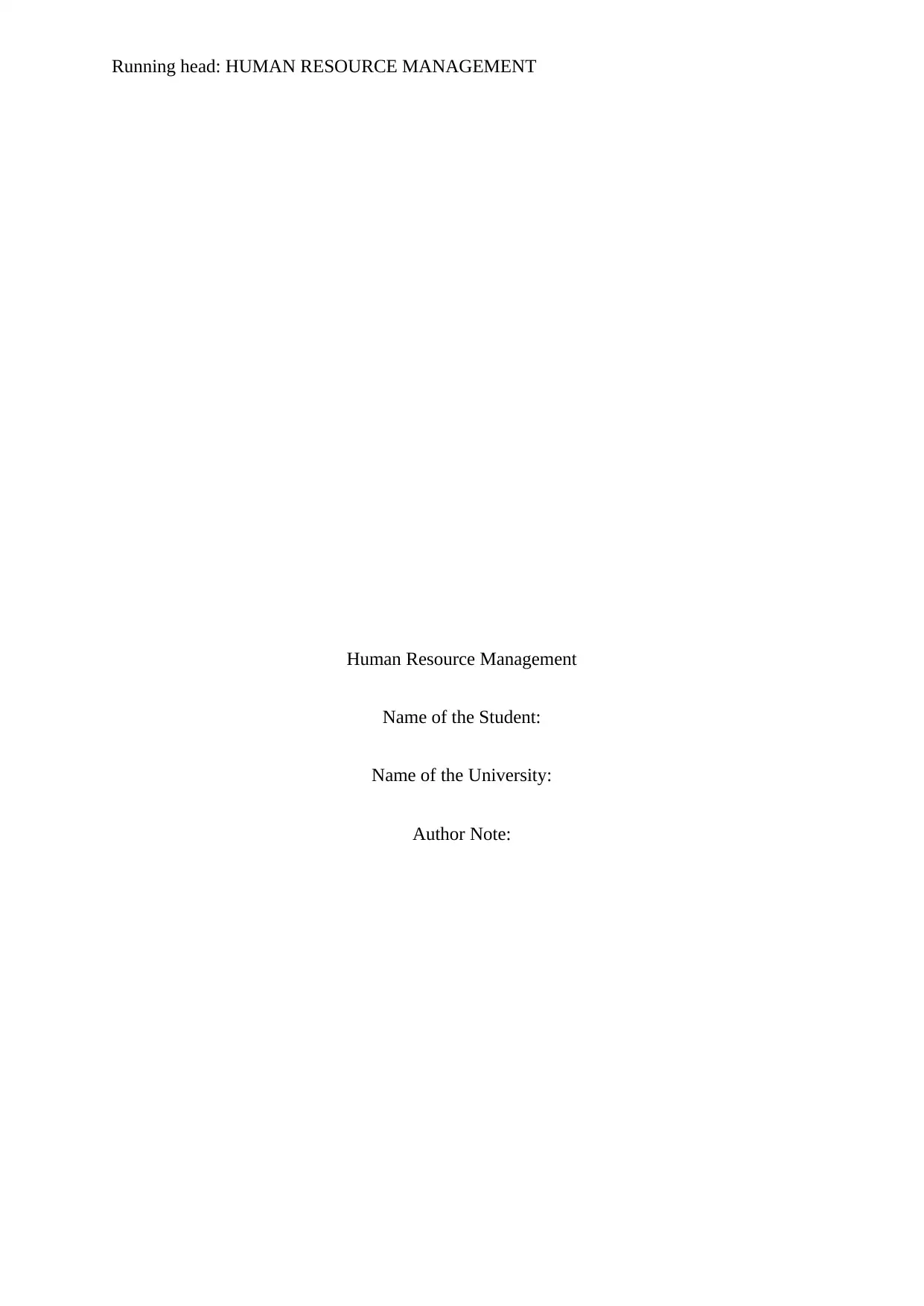
Running head: HUMAN RESOURCE MANAGEMENT
Human Resource Management
Name of the Student:
Name of the University:
Author Note:
Human Resource Management
Name of the Student:
Name of the University:
Author Note:
Paraphrase This Document
Need a fresh take? Get an instant paraphrase of this document with our AI Paraphraser
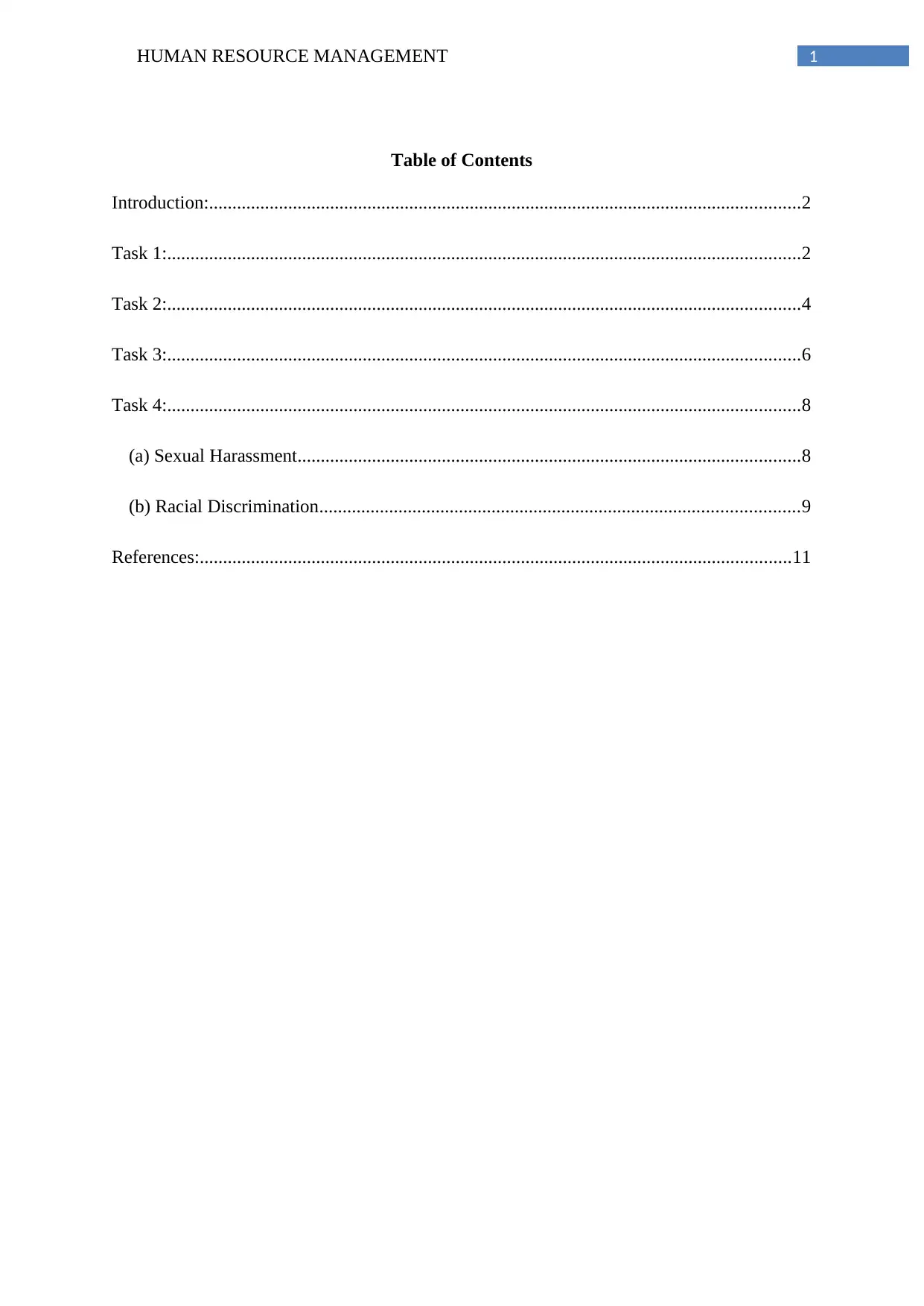
1HUMAN RESOURCE MANAGEMENT
Table of Contents
Introduction:...............................................................................................................................2
Task 1:........................................................................................................................................2
Task 2:........................................................................................................................................4
Task 3:........................................................................................................................................6
Task 4:........................................................................................................................................8
(a) Sexual Harassment............................................................................................................8
(b) Racial Discrimination.......................................................................................................9
References:...............................................................................................................................11
Table of Contents
Introduction:...............................................................................................................................2
Task 1:........................................................................................................................................2
Task 2:........................................................................................................................................4
Task 3:........................................................................................................................................6
Task 4:........................................................................................................................................8
(a) Sexual Harassment............................................................................................................8
(b) Racial Discrimination.......................................................................................................9
References:...............................................................................................................................11
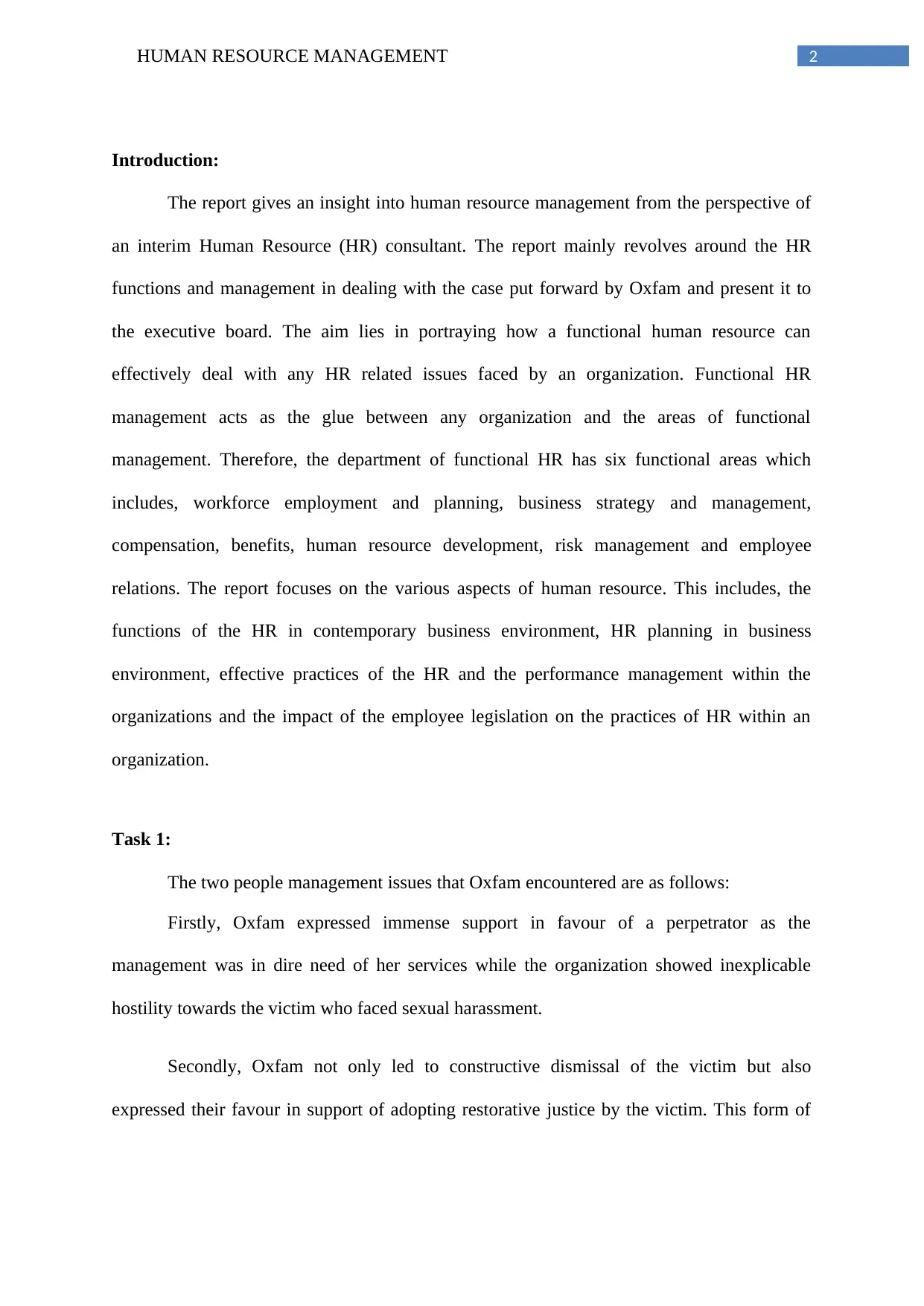
2HUMAN RESOURCE MANAGEMENT
Introduction:
The report gives an insight into human resource management from the perspective of
an interim Human Resource (HR) consultant. The report mainly revolves around the HR
functions and management in dealing with the case put forward by Oxfam and present it to
the executive board. The aim lies in portraying how a functional human resource can
effectively deal with any HR related issues faced by an organization. Functional HR
management acts as the glue between any organization and the areas of functional
management. Therefore, the department of functional HR has six functional areas which
includes, workforce employment and planning, business strategy and management,
compensation, benefits, human resource development, risk management and employee
relations. The report focuses on the various aspects of human resource. This includes, the
functions of the HR in contemporary business environment, HR planning in business
environment, effective practices of the HR and the performance management within the
organizations and the impact of the employee legislation on the practices of HR within an
organization.
Task 1:
The two people management issues that Oxfam encountered are as follows:
Firstly, Oxfam expressed immense support in favour of a perpetrator as the
management was in dire need of her services while the organization showed inexplicable
hostility towards the victim who faced sexual harassment.
Secondly, Oxfam not only led to constructive dismissal of the victim but also
expressed their favour in support of adopting restorative justice by the victim. This form of
Introduction:
The report gives an insight into human resource management from the perspective of
an interim Human Resource (HR) consultant. The report mainly revolves around the HR
functions and management in dealing with the case put forward by Oxfam and present it to
the executive board. The aim lies in portraying how a functional human resource can
effectively deal with any HR related issues faced by an organization. Functional HR
management acts as the glue between any organization and the areas of functional
management. Therefore, the department of functional HR has six functional areas which
includes, workforce employment and planning, business strategy and management,
compensation, benefits, human resource development, risk management and employee
relations. The report focuses on the various aspects of human resource. This includes, the
functions of the HR in contemporary business environment, HR planning in business
environment, effective practices of the HR and the performance management within the
organizations and the impact of the employee legislation on the practices of HR within an
organization.
Task 1:
The two people management issues that Oxfam encountered are as follows:
Firstly, Oxfam expressed immense support in favour of a perpetrator as the
management was in dire need of her services while the organization showed inexplicable
hostility towards the victim who faced sexual harassment.
Secondly, Oxfam not only led to constructive dismissal of the victim but also
expressed their favour in support of adopting restorative justice by the victim. This form of
⊘ This is a preview!⊘
Do you want full access?
Subscribe today to unlock all pages.

Trusted by 1+ million students worldwide
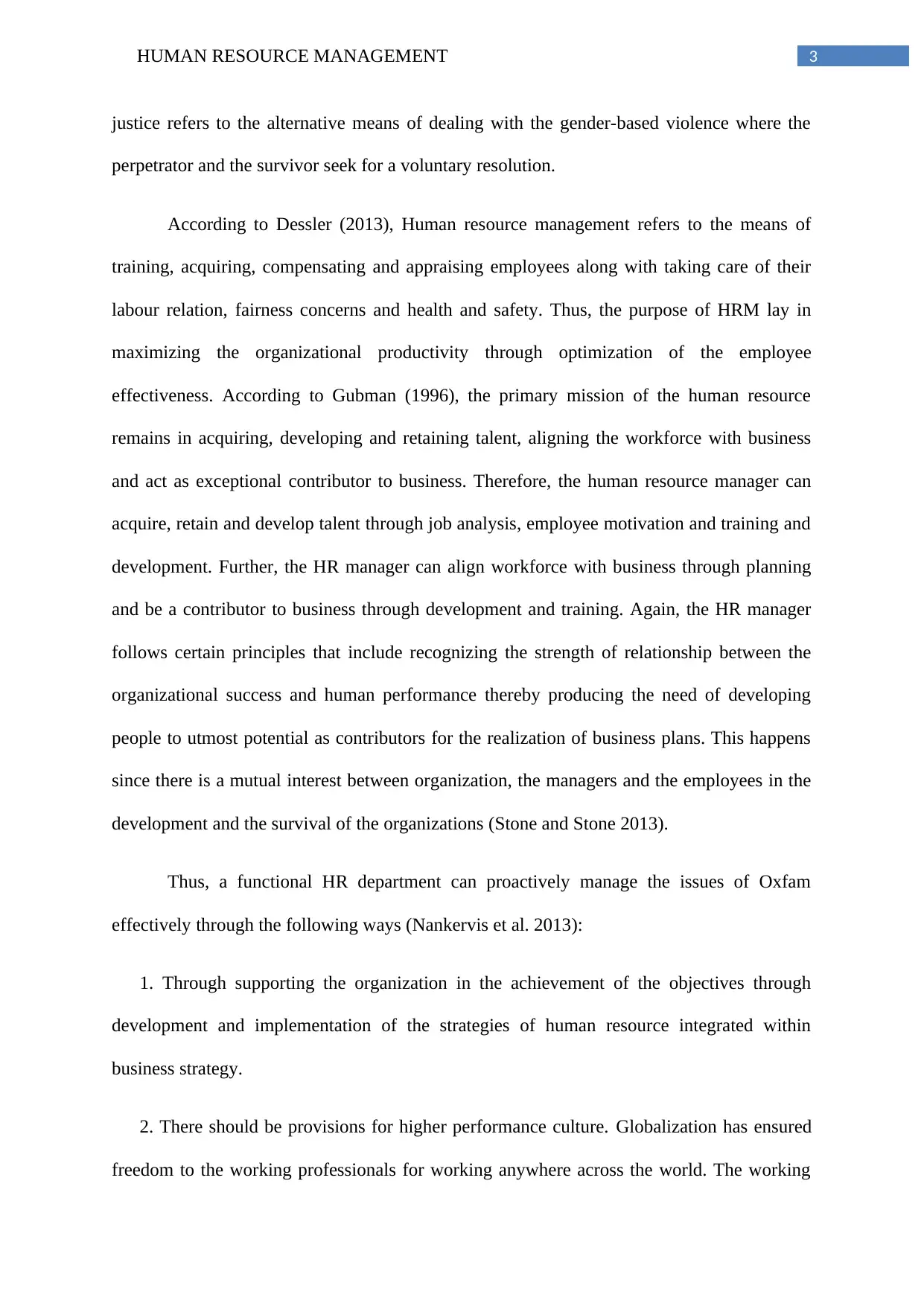
3HUMAN RESOURCE MANAGEMENT
justice refers to the alternative means of dealing with the gender-based violence where the
perpetrator and the survivor seek for a voluntary resolution.
According to Dessler (2013), Human resource management refers to the means of
training, acquiring, compensating and appraising employees along with taking care of their
labour relation, fairness concerns and health and safety. Thus, the purpose of HRM lay in
maximizing the organizational productivity through optimization of the employee
effectiveness. According to Gubman (1996), the primary mission of the human resource
remains in acquiring, developing and retaining talent, aligning the workforce with business
and act as exceptional contributor to business. Therefore, the human resource manager can
acquire, retain and develop talent through job analysis, employee motivation and training and
development. Further, the HR manager can align workforce with business through planning
and be a contributor to business through development and training. Again, the HR manager
follows certain principles that include recognizing the strength of relationship between the
organizational success and human performance thereby producing the need of developing
people to utmost potential as contributors for the realization of business plans. This happens
since there is a mutual interest between organization, the managers and the employees in the
development and the survival of the organizations (Stone and Stone 2013).
Thus, a functional HR department can proactively manage the issues of Oxfam
effectively through the following ways (Nankervis et al. 2013):
1. Through supporting the organization in the achievement of the objectives through
development and implementation of the strategies of human resource integrated within
business strategy.
2. There should be provisions for higher performance culture. Globalization has ensured
freedom to the working professionals for working anywhere across the world. The working
justice refers to the alternative means of dealing with the gender-based violence where the
perpetrator and the survivor seek for a voluntary resolution.
According to Dessler (2013), Human resource management refers to the means of
training, acquiring, compensating and appraising employees along with taking care of their
labour relation, fairness concerns and health and safety. Thus, the purpose of HRM lay in
maximizing the organizational productivity through optimization of the employee
effectiveness. According to Gubman (1996), the primary mission of the human resource
remains in acquiring, developing and retaining talent, aligning the workforce with business
and act as exceptional contributor to business. Therefore, the human resource manager can
acquire, retain and develop talent through job analysis, employee motivation and training and
development. Further, the HR manager can align workforce with business through planning
and be a contributor to business through development and training. Again, the HR manager
follows certain principles that include recognizing the strength of relationship between the
organizational success and human performance thereby producing the need of developing
people to utmost potential as contributors for the realization of business plans. This happens
since there is a mutual interest between organization, the managers and the employees in the
development and the survival of the organizations (Stone and Stone 2013).
Thus, a functional HR department can proactively manage the issues of Oxfam
effectively through the following ways (Nankervis et al. 2013):
1. Through supporting the organization in the achievement of the objectives through
development and implementation of the strategies of human resource integrated within
business strategy.
2. There should be provisions for higher performance culture. Globalization has ensured
freedom to the working professionals for working anywhere across the world. The working
Paraphrase This Document
Need a fresh take? Get an instant paraphrase of this document with our AI Paraphraser
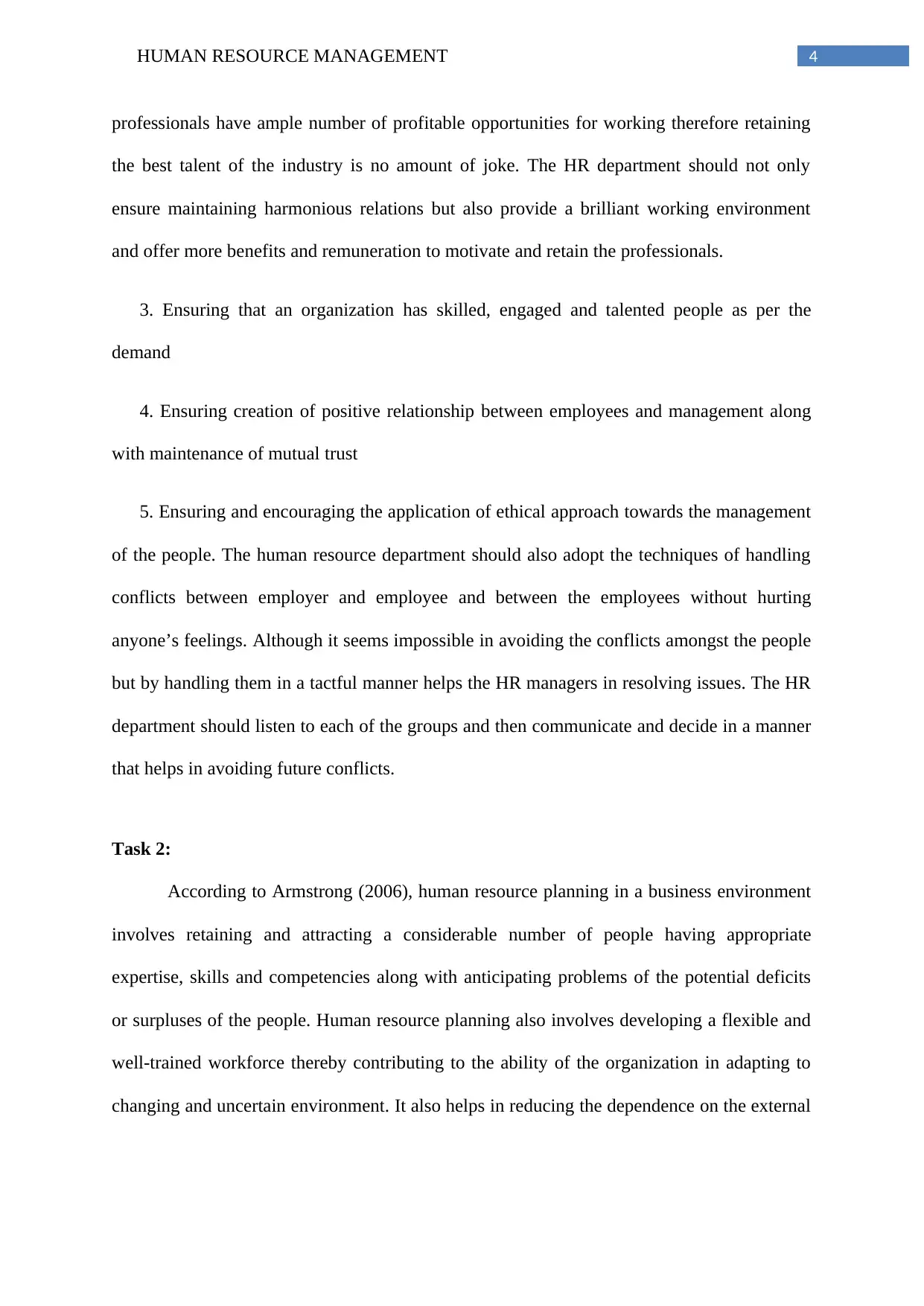
4HUMAN RESOURCE MANAGEMENT
professionals have ample number of profitable opportunities for working therefore retaining
the best talent of the industry is no amount of joke. The HR department should not only
ensure maintaining harmonious relations but also provide a brilliant working environment
and offer more benefits and remuneration to motivate and retain the professionals.
3. Ensuring that an organization has skilled, engaged and talented people as per the
demand
4. Ensuring creation of positive relationship between employees and management along
with maintenance of mutual trust
5. Ensuring and encouraging the application of ethical approach towards the management
of the people. The human resource department should also adopt the techniques of handling
conflicts between employer and employee and between the employees without hurting
anyone’s feelings. Although it seems impossible in avoiding the conflicts amongst the people
but by handling them in a tactful manner helps the HR managers in resolving issues. The HR
department should listen to each of the groups and then communicate and decide in a manner
that helps in avoiding future conflicts.
Task 2:
According to Armstrong (2006), human resource planning in a business environment
involves retaining and attracting a considerable number of people having appropriate
expertise, skills and competencies along with anticipating problems of the potential deficits
or surpluses of the people. Human resource planning also involves developing a flexible and
well-trained workforce thereby contributing to the ability of the organization in adapting to
changing and uncertain environment. It also helps in reducing the dependence on the external
professionals have ample number of profitable opportunities for working therefore retaining
the best talent of the industry is no amount of joke. The HR department should not only
ensure maintaining harmonious relations but also provide a brilliant working environment
and offer more benefits and remuneration to motivate and retain the professionals.
3. Ensuring that an organization has skilled, engaged and talented people as per the
demand
4. Ensuring creation of positive relationship between employees and management along
with maintenance of mutual trust
5. Ensuring and encouraging the application of ethical approach towards the management
of the people. The human resource department should also adopt the techniques of handling
conflicts between employer and employee and between the employees without hurting
anyone’s feelings. Although it seems impossible in avoiding the conflicts amongst the people
but by handling them in a tactful manner helps the HR managers in resolving issues. The HR
department should listen to each of the groups and then communicate and decide in a manner
that helps in avoiding future conflicts.
Task 2:
According to Armstrong (2006), human resource planning in a business environment
involves retaining and attracting a considerable number of people having appropriate
expertise, skills and competencies along with anticipating problems of the potential deficits
or surpluses of the people. Human resource planning also involves developing a flexible and
well-trained workforce thereby contributing to the ability of the organization in adapting to
changing and uncertain environment. It also helps in reducing the dependence on the external
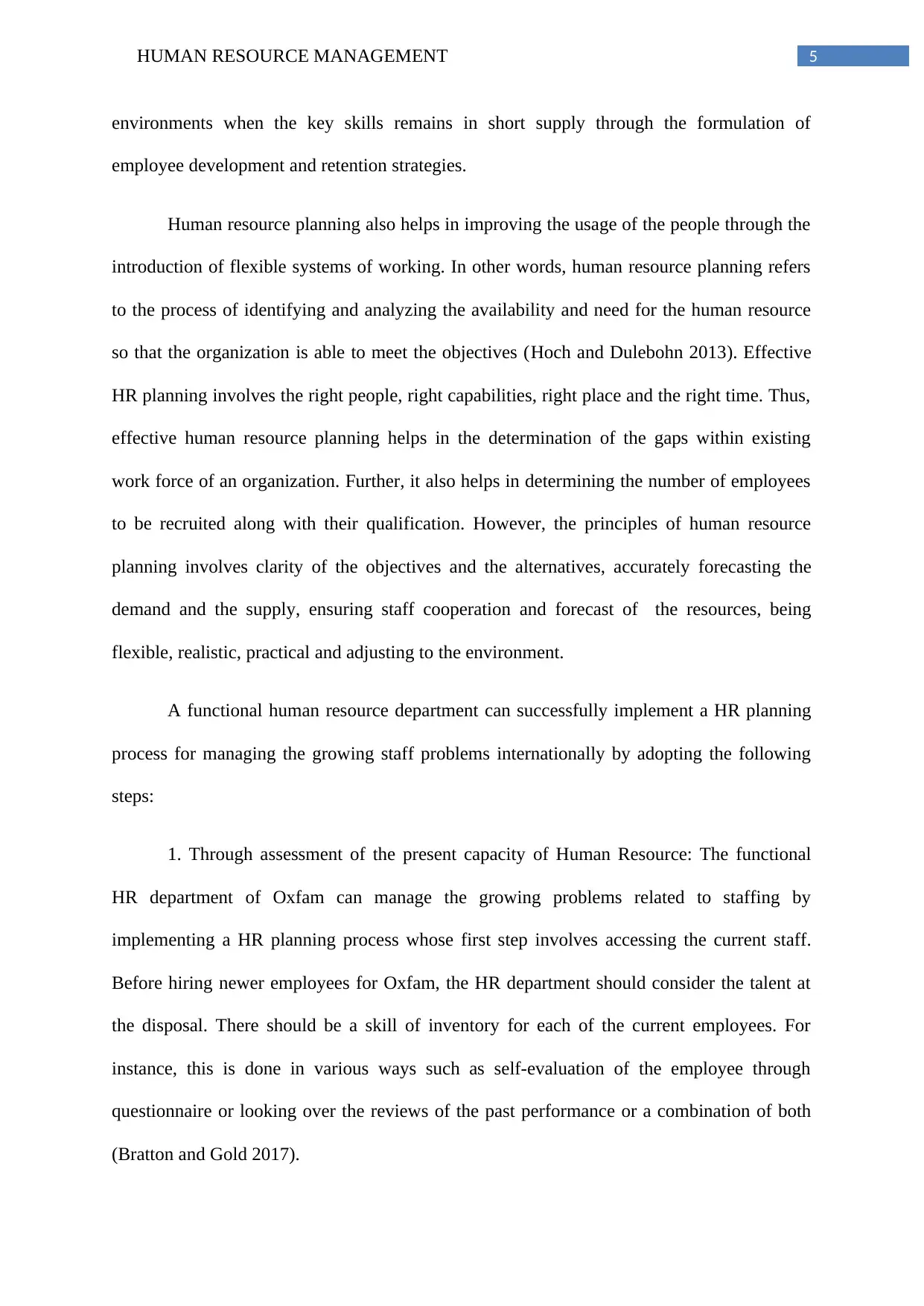
5HUMAN RESOURCE MANAGEMENT
environments when the key skills remains in short supply through the formulation of
employee development and retention strategies.
Human resource planning also helps in improving the usage of the people through the
introduction of flexible systems of working. In other words, human resource planning refers
to the process of identifying and analyzing the availability and need for the human resource
so that the organization is able to meet the objectives (Hoch and Dulebohn 2013). Effective
HR planning involves the right people, right capabilities, right place and the right time. Thus,
effective human resource planning helps in the determination of the gaps within existing
work force of an organization. Further, it also helps in determining the number of employees
to be recruited along with their qualification. However, the principles of human resource
planning involves clarity of the objectives and the alternatives, accurately forecasting the
demand and the supply, ensuring staff cooperation and forecast of the resources, being
flexible, realistic, practical and adjusting to the environment.
A functional human resource department can successfully implement a HR planning
process for managing the growing staff problems internationally by adopting the following
steps:
1. Through assessment of the present capacity of Human Resource: The functional
HR department of Oxfam can manage the growing problems related to staffing by
implementing a HR planning process whose first step involves accessing the current staff.
Before hiring newer employees for Oxfam, the HR department should consider the talent at
the disposal. There should be a skill of inventory for each of the current employees. For
instance, this is done in various ways such as self-evaluation of the employee through
questionnaire or looking over the reviews of the past performance or a combination of both
(Bratton and Gold 2017).
environments when the key skills remains in short supply through the formulation of
employee development and retention strategies.
Human resource planning also helps in improving the usage of the people through the
introduction of flexible systems of working. In other words, human resource planning refers
to the process of identifying and analyzing the availability and need for the human resource
so that the organization is able to meet the objectives (Hoch and Dulebohn 2013). Effective
HR planning involves the right people, right capabilities, right place and the right time. Thus,
effective human resource planning helps in the determination of the gaps within existing
work force of an organization. Further, it also helps in determining the number of employees
to be recruited along with their qualification. However, the principles of human resource
planning involves clarity of the objectives and the alternatives, accurately forecasting the
demand and the supply, ensuring staff cooperation and forecast of the resources, being
flexible, realistic, practical and adjusting to the environment.
A functional human resource department can successfully implement a HR planning
process for managing the growing staff problems internationally by adopting the following
steps:
1. Through assessment of the present capacity of Human Resource: The functional
HR department of Oxfam can manage the growing problems related to staffing by
implementing a HR planning process whose first step involves accessing the current staff.
Before hiring newer employees for Oxfam, the HR department should consider the talent at
the disposal. There should be a skill of inventory for each of the current employees. For
instance, this is done in various ways such as self-evaluation of the employee through
questionnaire or looking over the reviews of the past performance or a combination of both
(Bratton and Gold 2017).
⊘ This is a preview!⊘
Do you want full access?
Subscribe today to unlock all pages.

Trusted by 1+ million students worldwide

6HUMAN RESOURCE MANAGEMENT
2. Through Forecasting of the Requirements of Human Resource: The functional
human resource department of HR at Oxfam should access the demand of the company for
the qualified employees against the supply of these employees either outside or within the
organization. Thus, the careful management of demand and supply plays a vital role. Demand
forecasting refers to the number of demanded employees in terms of quality and calibre for
meeting Oxfam’s present and the future needs. The supply forecasting however, refers to the
present resources necessary to meet the market demand. Thus, the HR planning process in
Oxfam should be such that it matches the demand and the supply (Aswathappa 2013). For
instance, the HR department can achieve this through hiring of newer employees or training
of the current employees or through combining both approaches.
3. By Developing the Talent Strategies: The functional HR department can deal with
the issues of international staffing through talent development. For instance, the steps for this
include recruitment, selection, hiring, development and training, remuneration, performance
management and employee relations (Oladapo 2014).
4. Undertaking the Process of Review and Evaluation: It is also necessary for the
functional HR department at Oxfam to undertake an evaluation whether their planning
process has enabled the company in achieving the goals related to profit, production,
employee satisfaction and retention (Smither, Houston and McIntire 2016).
Task 3:
The employee performance is based on outcomes. Performance is even measured
based terms of the behaviour. According to Kehoe and Wright (2013), the employee
performance is measured against performance standards put forward by an organization. A
number of measures need consideration while measuring the performance of the employees.
These included the efficiency, productivity, effectiveness, profitability measures and quality.
2. Through Forecasting of the Requirements of Human Resource: The functional
human resource department of HR at Oxfam should access the demand of the company for
the qualified employees against the supply of these employees either outside or within the
organization. Thus, the careful management of demand and supply plays a vital role. Demand
forecasting refers to the number of demanded employees in terms of quality and calibre for
meeting Oxfam’s present and the future needs. The supply forecasting however, refers to the
present resources necessary to meet the market demand. Thus, the HR planning process in
Oxfam should be such that it matches the demand and the supply (Aswathappa 2013). For
instance, the HR department can achieve this through hiring of newer employees or training
of the current employees or through combining both approaches.
3. By Developing the Talent Strategies: The functional HR department can deal with
the issues of international staffing through talent development. For instance, the steps for this
include recruitment, selection, hiring, development and training, remuneration, performance
management and employee relations (Oladapo 2014).
4. Undertaking the Process of Review and Evaluation: It is also necessary for the
functional HR department at Oxfam to undertake an evaluation whether their planning
process has enabled the company in achieving the goals related to profit, production,
employee satisfaction and retention (Smither, Houston and McIntire 2016).
Task 3:
The employee performance is based on outcomes. Performance is even measured
based terms of the behaviour. According to Kehoe and Wright (2013), the employee
performance is measured against performance standards put forward by an organization. A
number of measures need consideration while measuring the performance of the employees.
These included the efficiency, productivity, effectiveness, profitability measures and quality.
Paraphrase This Document
Need a fresh take? Get an instant paraphrase of this document with our AI Paraphraser
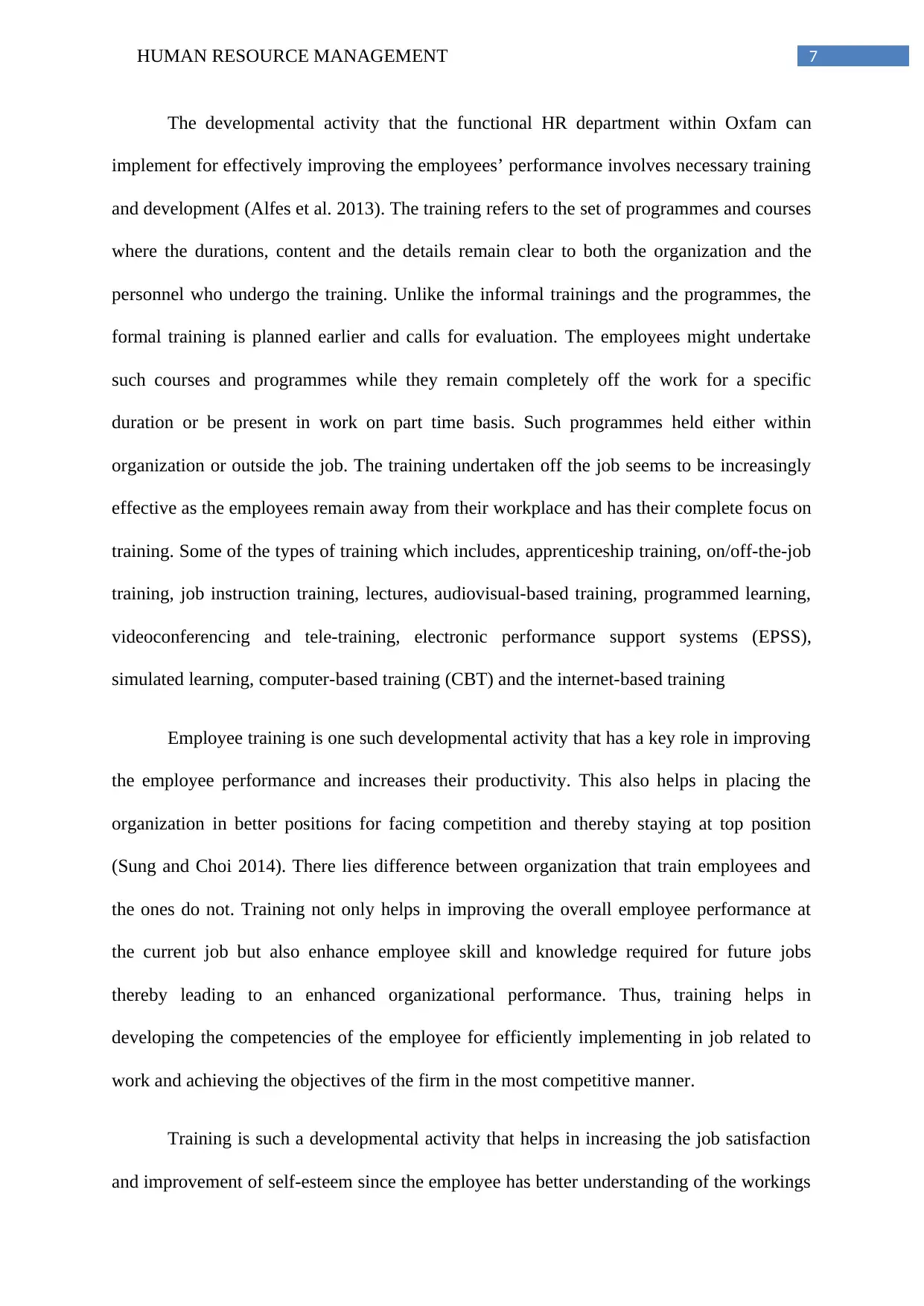
7HUMAN RESOURCE MANAGEMENT
The developmental activity that the functional HR department within Oxfam can
implement for effectively improving the employees’ performance involves necessary training
and development (Alfes et al. 2013). The training refers to the set of programmes and courses
where the durations, content and the details remain clear to both the organization and the
personnel who undergo the training. Unlike the informal trainings and the programmes, the
formal training is planned earlier and calls for evaluation. The employees might undertake
such courses and programmes while they remain completely off the work for a specific
duration or be present in work on part time basis. Such programmes held either within
organization or outside the job. The training undertaken off the job seems to be increasingly
effective as the employees remain away from their workplace and has their complete focus on
training. Some of the types of training which includes, apprenticeship training, on/off-the-job
training, job instruction training, lectures, audiovisual-based training, programmed learning,
videoconferencing and tele-training, electronic performance support systems (EPSS),
simulated learning, computer-based training (CBT) and the internet-based training
Employee training is one such developmental activity that has a key role in improving
the employee performance and increases their productivity. This also helps in placing the
organization in better positions for facing competition and thereby staying at top position
(Sung and Choi 2014). There lies difference between organization that train employees and
the ones do not. Training not only helps in improving the overall employee performance at
the current job but also enhance employee skill and knowledge required for future jobs
thereby leading to an enhanced organizational performance. Thus, training helps in
developing the competencies of the employee for efficiently implementing in job related to
work and achieving the objectives of the firm in the most competitive manner.
Training is such a developmental activity that helps in increasing the job satisfaction
and improvement of self-esteem since the employee has better understanding of the workings
The developmental activity that the functional HR department within Oxfam can
implement for effectively improving the employees’ performance involves necessary training
and development (Alfes et al. 2013). The training refers to the set of programmes and courses
where the durations, content and the details remain clear to both the organization and the
personnel who undergo the training. Unlike the informal trainings and the programmes, the
formal training is planned earlier and calls for evaluation. The employees might undertake
such courses and programmes while they remain completely off the work for a specific
duration or be present in work on part time basis. Such programmes held either within
organization or outside the job. The training undertaken off the job seems to be increasingly
effective as the employees remain away from their workplace and has their complete focus on
training. Some of the types of training which includes, apprenticeship training, on/off-the-job
training, job instruction training, lectures, audiovisual-based training, programmed learning,
videoconferencing and tele-training, electronic performance support systems (EPSS),
simulated learning, computer-based training (CBT) and the internet-based training
Employee training is one such developmental activity that has a key role in improving
the employee performance and increases their productivity. This also helps in placing the
organization in better positions for facing competition and thereby staying at top position
(Sung and Choi 2014). There lies difference between organization that train employees and
the ones do not. Training not only helps in improving the overall employee performance at
the current job but also enhance employee skill and knowledge required for future jobs
thereby leading to an enhanced organizational performance. Thus, training helps in
developing the competencies of the employee for efficiently implementing in job related to
work and achieving the objectives of the firm in the most competitive manner.
Training is such a developmental activity that helps in increasing the job satisfaction
and improvement of self-esteem since the employee has better understanding of the workings

8HUMAN RESOURCE MANAGEMENT
within the company (Elnaga and Imran 2013). It will also help the employee at Oxfam in
enhancing their morale and loyalty towards the company. Excellent training opportunities
will in reducing the attrition rate.
Training can also enhance employee commitment at Oxfam provided it meets the
needs and expectations of employees (Albrecht et al. 2015). Moreover, the companies retain
employees who accept their training and are subsequently committed to the company.
Successful training program involves the management in providing the accurate
communication and information regarding the training.
Well-trained employees at Oxfam can ensure paying off significantly for the
companies since the employee turnover remains quite high (Phipps, Prieto and Ndinguri
2013). The cost involves the separation costs that included the exit interviews, administrative
functions in relation to the termination, unemployment compensation and severance pay.
Task 4:
(a) Sexual Harassment
Sexual harassment has been an important portion of the Equality Act in the United
Kingdom (Hepple 2014). However, close to two thirds of the women experiences sexual
harassment at the work place. Thus, by providing route for the individuals in bringing about
claim for harassment does not prove sufficient in stamping out discriminatory behaviour and
attitudes of women at the workplace.
The employment legislation on sexual harassment influences the current practices of
human resource department at Oxfam are as follows:
within the company (Elnaga and Imran 2013). It will also help the employee at Oxfam in
enhancing their morale and loyalty towards the company. Excellent training opportunities
will in reducing the attrition rate.
Training can also enhance employee commitment at Oxfam provided it meets the
needs and expectations of employees (Albrecht et al. 2015). Moreover, the companies retain
employees who accept their training and are subsequently committed to the company.
Successful training program involves the management in providing the accurate
communication and information regarding the training.
Well-trained employees at Oxfam can ensure paying off significantly for the
companies since the employee turnover remains quite high (Phipps, Prieto and Ndinguri
2013). The cost involves the separation costs that included the exit interviews, administrative
functions in relation to the termination, unemployment compensation and severance pay.
Task 4:
(a) Sexual Harassment
Sexual harassment has been an important portion of the Equality Act in the United
Kingdom (Hepple 2014). However, close to two thirds of the women experiences sexual
harassment at the work place. Thus, by providing route for the individuals in bringing about
claim for harassment does not prove sufficient in stamping out discriminatory behaviour and
attitudes of women at the workplace.
The employment legislation on sexual harassment influences the current practices of
human resource department at Oxfam are as follows:
⊘ This is a preview!⊘
Do you want full access?
Subscribe today to unlock all pages.

Trusted by 1+ million students worldwide
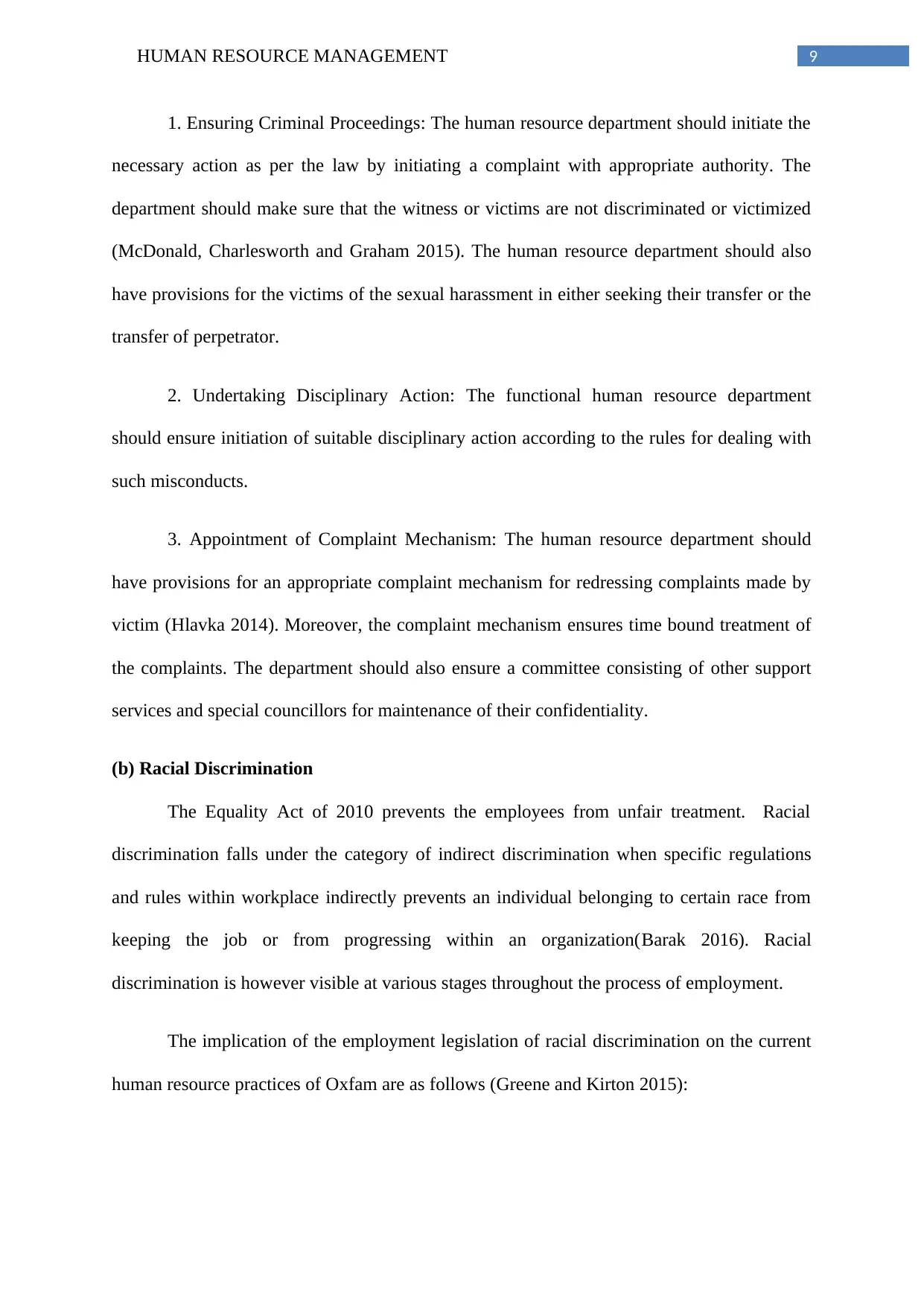
9HUMAN RESOURCE MANAGEMENT
1. Ensuring Criminal Proceedings: The human resource department should initiate the
necessary action as per the law by initiating a complaint with appropriate authority. The
department should make sure that the witness or victims are not discriminated or victimized
(McDonald, Charlesworth and Graham 2015). The human resource department should also
have provisions for the victims of the sexual harassment in either seeking their transfer or the
transfer of perpetrator.
2. Undertaking Disciplinary Action: The functional human resource department
should ensure initiation of suitable disciplinary action according to the rules for dealing with
such misconducts.
3. Appointment of Complaint Mechanism: The human resource department should
have provisions for an appropriate complaint mechanism for redressing complaints made by
victim (Hlavka 2014). Moreover, the complaint mechanism ensures time bound treatment of
the complaints. The department should also ensure a committee consisting of other support
services and special councillors for maintenance of their confidentiality.
(b) Racial Discrimination
The Equality Act of 2010 prevents the employees from unfair treatment. Racial
discrimination falls under the category of indirect discrimination when specific regulations
and rules within workplace indirectly prevents an individual belonging to certain race from
keeping the job or from progressing within an organization(Barak 2016). Racial
discrimination is however visible at various stages throughout the process of employment.
The implication of the employment legislation of racial discrimination on the current
human resource practices of Oxfam are as follows (Greene and Kirton 2015):
1. Ensuring Criminal Proceedings: The human resource department should initiate the
necessary action as per the law by initiating a complaint with appropriate authority. The
department should make sure that the witness or victims are not discriminated or victimized
(McDonald, Charlesworth and Graham 2015). The human resource department should also
have provisions for the victims of the sexual harassment in either seeking their transfer or the
transfer of perpetrator.
2. Undertaking Disciplinary Action: The functional human resource department
should ensure initiation of suitable disciplinary action according to the rules for dealing with
such misconducts.
3. Appointment of Complaint Mechanism: The human resource department should
have provisions for an appropriate complaint mechanism for redressing complaints made by
victim (Hlavka 2014). Moreover, the complaint mechanism ensures time bound treatment of
the complaints. The department should also ensure a committee consisting of other support
services and special councillors for maintenance of their confidentiality.
(b) Racial Discrimination
The Equality Act of 2010 prevents the employees from unfair treatment. Racial
discrimination falls under the category of indirect discrimination when specific regulations
and rules within workplace indirectly prevents an individual belonging to certain race from
keeping the job or from progressing within an organization(Barak 2016). Racial
discrimination is however visible at various stages throughout the process of employment.
The implication of the employment legislation of racial discrimination on the current
human resource practices of Oxfam are as follows (Greene and Kirton 2015):
Paraphrase This Document
Need a fresh take? Get an instant paraphrase of this document with our AI Paraphraser
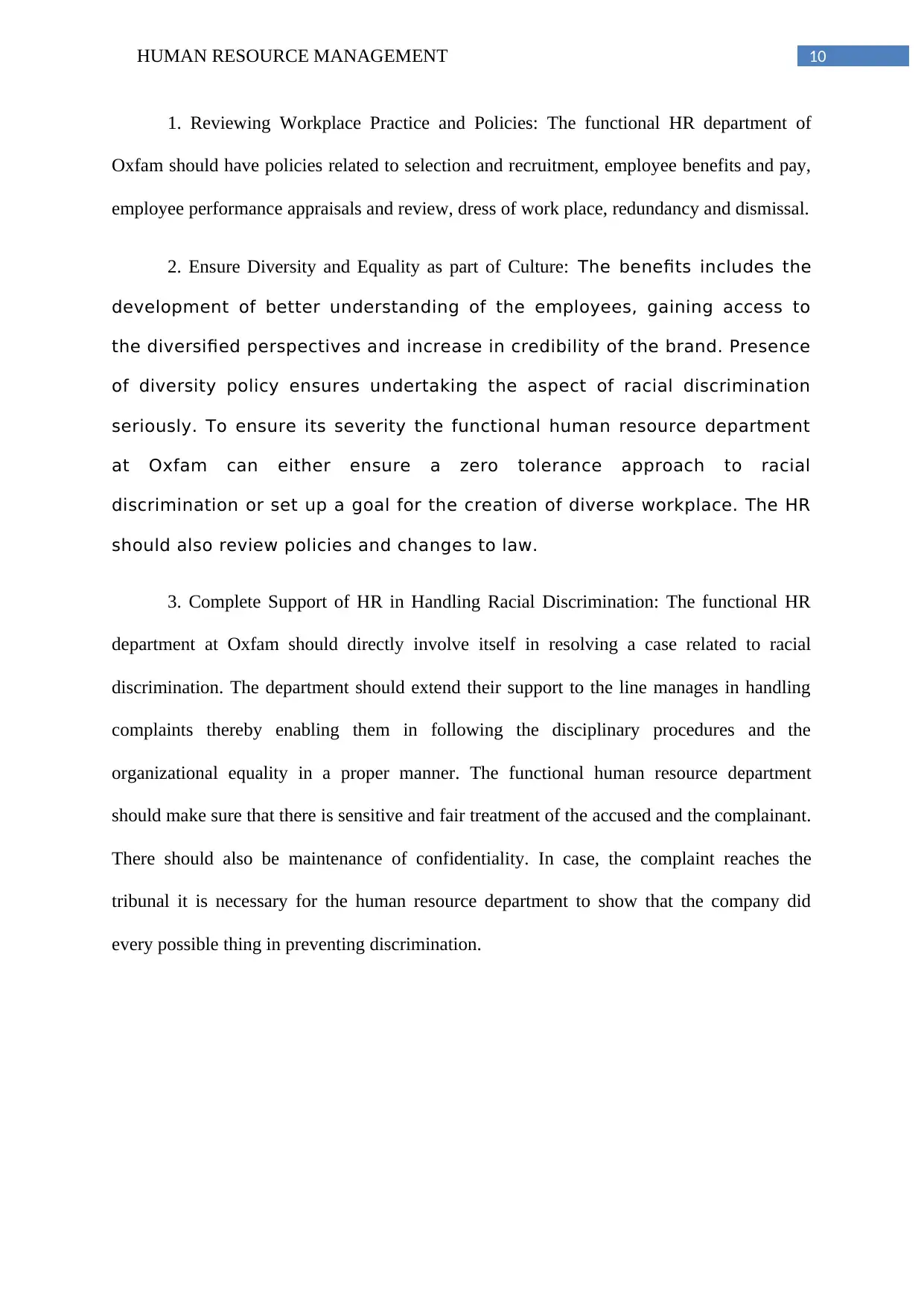
10HUMAN RESOURCE MANAGEMENT
1. Reviewing Workplace Practice and Policies: The functional HR department of
Oxfam should have policies related to selection and recruitment, employee benefits and pay,
employee performance appraisals and review, dress of work place, redundancy and dismissal.
2. Ensure Diversity and Equality as part of Culture: The benefits includes the
development of better understanding of the employees, gaining access to
the diversified perspectives and increase in credibility of the brand. Presence
of diversity policy ensures undertaking the aspect of racial discrimination
seriously. To ensure its severity the functional human resource department
at Oxfam can either ensure a zero tolerance approach to racial
discrimination or set up a goal for the creation of diverse workplace. The HR
should also review policies and changes to law.
3. Complete Support of HR in Handling Racial Discrimination: The functional HR
department at Oxfam should directly involve itself in resolving a case related to racial
discrimination. The department should extend their support to the line manages in handling
complaints thereby enabling them in following the disciplinary procedures and the
organizational equality in a proper manner. The functional human resource department
should make sure that there is sensitive and fair treatment of the accused and the complainant.
There should also be maintenance of confidentiality. In case, the complaint reaches the
tribunal it is necessary for the human resource department to show that the company did
every possible thing in preventing discrimination.
1. Reviewing Workplace Practice and Policies: The functional HR department of
Oxfam should have policies related to selection and recruitment, employee benefits and pay,
employee performance appraisals and review, dress of work place, redundancy and dismissal.
2. Ensure Diversity and Equality as part of Culture: The benefits includes the
development of better understanding of the employees, gaining access to
the diversified perspectives and increase in credibility of the brand. Presence
of diversity policy ensures undertaking the aspect of racial discrimination
seriously. To ensure its severity the functional human resource department
at Oxfam can either ensure a zero tolerance approach to racial
discrimination or set up a goal for the creation of diverse workplace. The HR
should also review policies and changes to law.
3. Complete Support of HR in Handling Racial Discrimination: The functional HR
department at Oxfam should directly involve itself in resolving a case related to racial
discrimination. The department should extend their support to the line manages in handling
complaints thereby enabling them in following the disciplinary procedures and the
organizational equality in a proper manner. The functional human resource department
should make sure that there is sensitive and fair treatment of the accused and the complainant.
There should also be maintenance of confidentiality. In case, the complaint reaches the
tribunal it is necessary for the human resource department to show that the company did
every possible thing in preventing discrimination.
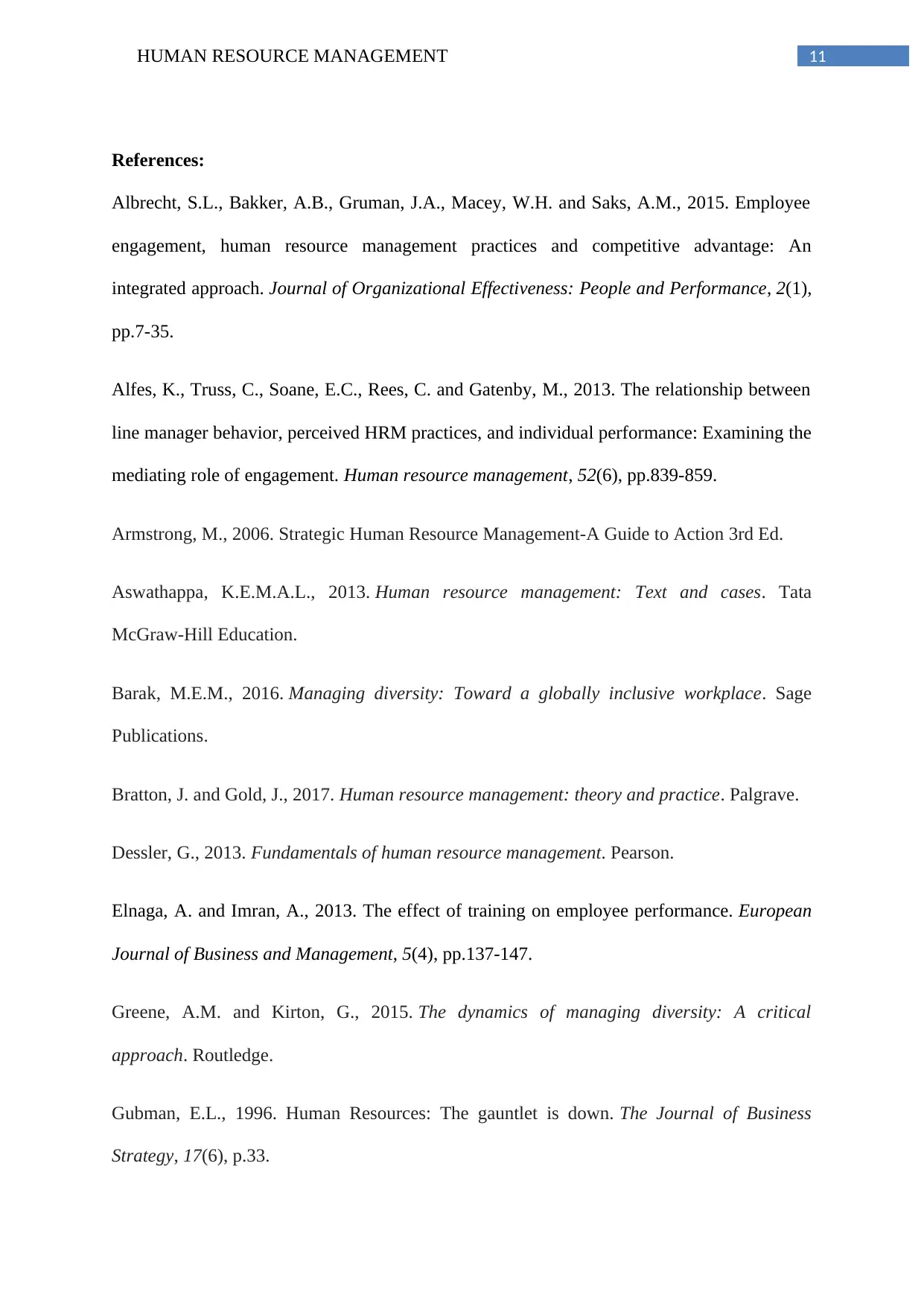
11HUMAN RESOURCE MANAGEMENT
References:
Albrecht, S.L., Bakker, A.B., Gruman, J.A., Macey, W.H. and Saks, A.M., 2015. Employee
engagement, human resource management practices and competitive advantage: An
integrated approach. Journal of Organizational Effectiveness: People and Performance, 2(1),
pp.7-35.
Alfes, K., Truss, C., Soane, E.C., Rees, C. and Gatenby, M., 2013. The relationship between
line manager behavior, perceived HRM practices, and individual performance: Examining the
mediating role of engagement. Human resource management, 52(6), pp.839-859.
Armstrong, M., 2006. Strategic Human Resource Management-A Guide to Action 3rd Ed.
Aswathappa, K.E.M.A.L., 2013. Human resource management: Text and cases. Tata
McGraw-Hill Education.
Barak, M.E.M., 2016. Managing diversity: Toward a globally inclusive workplace. Sage
Publications.
Bratton, J. and Gold, J., 2017. Human resource management: theory and practice. Palgrave.
Dessler, G., 2013. Fundamentals of human resource management. Pearson.
Elnaga, A. and Imran, A., 2013. The effect of training on employee performance. European
Journal of Business and Management, 5(4), pp.137-147.
Greene, A.M. and Kirton, G., 2015. The dynamics of managing diversity: A critical
approach. Routledge.
Gubman, E.L., 1996. Human Resources: The gauntlet is down. The Journal of Business
Strategy, 17(6), p.33.
References:
Albrecht, S.L., Bakker, A.B., Gruman, J.A., Macey, W.H. and Saks, A.M., 2015. Employee
engagement, human resource management practices and competitive advantage: An
integrated approach. Journal of Organizational Effectiveness: People and Performance, 2(1),
pp.7-35.
Alfes, K., Truss, C., Soane, E.C., Rees, C. and Gatenby, M., 2013. The relationship between
line manager behavior, perceived HRM practices, and individual performance: Examining the
mediating role of engagement. Human resource management, 52(6), pp.839-859.
Armstrong, M., 2006. Strategic Human Resource Management-A Guide to Action 3rd Ed.
Aswathappa, K.E.M.A.L., 2013. Human resource management: Text and cases. Tata
McGraw-Hill Education.
Barak, M.E.M., 2016. Managing diversity: Toward a globally inclusive workplace. Sage
Publications.
Bratton, J. and Gold, J., 2017. Human resource management: theory and practice. Palgrave.
Dessler, G., 2013. Fundamentals of human resource management. Pearson.
Elnaga, A. and Imran, A., 2013. The effect of training on employee performance. European
Journal of Business and Management, 5(4), pp.137-147.
Greene, A.M. and Kirton, G., 2015. The dynamics of managing diversity: A critical
approach. Routledge.
Gubman, E.L., 1996. Human Resources: The gauntlet is down. The Journal of Business
Strategy, 17(6), p.33.
⊘ This is a preview!⊘
Do you want full access?
Subscribe today to unlock all pages.

Trusted by 1+ million students worldwide
1 out of 14
Related Documents
Your All-in-One AI-Powered Toolkit for Academic Success.
+13062052269
info@desklib.com
Available 24*7 on WhatsApp / Email
![[object Object]](/_next/static/media/star-bottom.7253800d.svg)
Unlock your academic potential
Copyright © 2020–2025 A2Z Services. All Rights Reserved. Developed and managed by ZUCOL.





